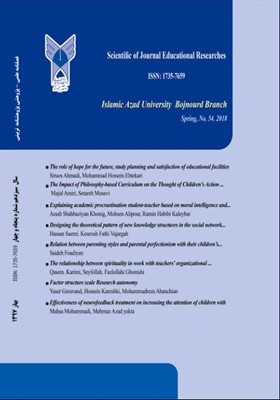-
-
List of Articles
-
Open Access Article
1 - The role of hope for the future, study planning and satisfaction of educational facilities in the student's Dropout
siroos ahmadi mohammad hossein ebtekari -
Open Access Article
2 - The Impact of Philosophy-based Curriculum on Children's Action-Based Thinking Based
Majid Amiri setareh Mousavi -
Open Access Article
3 - Explaining academic procrastination student-teacher based on moral intelligence and study habits
Arash shahbaziyankhonig mohsen alipour Ramin Habibi Kaleybar -
Open Access Article
4 - Designing the theoretical pattern of new knowledge structures in the social network And improving the quality of education
hassan saemi kourosh fathivajargah -
Open Access Article
5 - Correlation parenting styles and dimensions Perfectionism with academic motivation their children on High school student damghan city
saideh fovadian -
Open Access Article
6 - The relationship between spirituality in work with teachers' organizational performance based on the components of the Achio model
khasem karimi sifollah fazllollahi -
Open Access Article
7 - Factor structure scale Research autonomy
yaser garavand حسین کارشکی محمدرضا آهنچیان -
Open Access Article
8 - Effectiveness of neurofeedback treatment on increasing the attention of children with attention deficit hyperactivity disorder (ADHD).
mahsa mohamadi mehrnaz azadyekta
-
The rights to this website are owned by the Raimag Press Management System.
Copyright © 2021-2025







